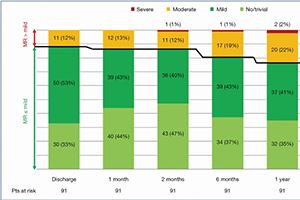Combining echocardiographic and anatomic variables to predict outcomes of mitral valve repair with the NeoChord procedure
Abstract
Background: Trans-apical, echo-guided NeoChord mitral valve (MV) repair is an innovative procedure to treat degenerative mitral regurgitation (MR) without concomitant annuloplasty. Recently, leaflet-to-annulus index (LAI) has been identified as a positive prognostic predictor of outcomes at 1-year follow up. The aim of this study is to develop a pre-operative predictor tool to assess probability of success with NeoChord procedure utilizing multi-factor echocardiographic and anatomic variables.
Methods: We included ninety-one consecutive patients with prolapse/flail of the posterior mitral leaflet, who subsequently underwent NeoChord MV repair between November 2013 and October 2016. All patients completed post-operative echocardiographic follow-up assessments for up to 2 years. A random forest regression algorithm identified and ranked the most relevant predictors of moderate-severe MR. A multi-variable Cox regression model was performed at follow-up intervals, to assess variables associated with residual MR that was classified as mild or less. Bootstrapping re-samples were used to validate an estimated survival model. Predictive accuracy was assessed using a discrimination index that corrected for over-optimism.
Results: We developed a nomogram which used the results of a multi-variable model to predict the probability of mild or less residual MR at follow-up periods (discharge, 1, 3, 6 months, 1 and 2 years). Identified predictors included LAI, systolic pulmonary artery pressure, indexed left ventricle end-systolic volume (iLVESV), prolapse/flail width (FW), systolic antero-posterior (AP) annulus diameter, systolic latero-lateral (LL) annulus diameter and presence of calcification.
Conclusions: A NeoChord MV repair prediction tool would be helpful in clinical decision-making and in the identification of patients who may benefit from a ringless mitral valve repair using the NeoChord procedure.
Cover






